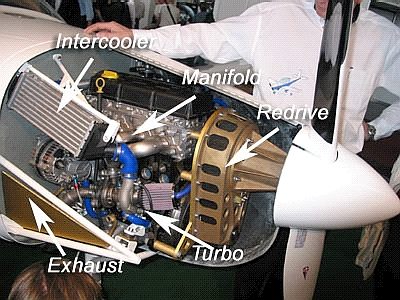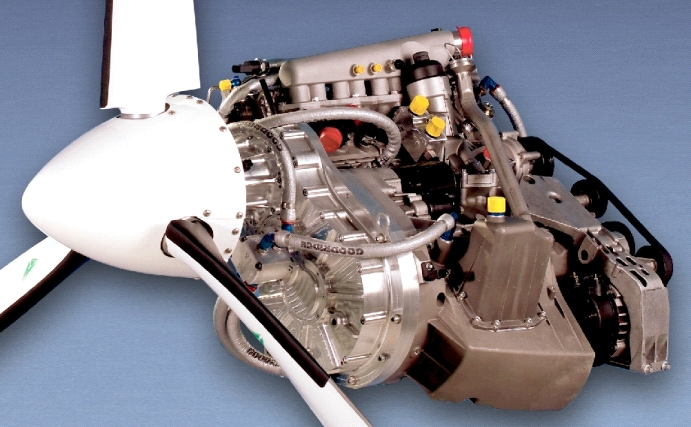|
IS
THERE A DIESEL IN YOUR FUTURE?
Recently, the buzz in
engines has been around diesels, especially in Europe.
Remember when we talked about the infrastructure for alcohol
fuel? Well, the problem is much easier with diesel because
Jet A is already commonly available and, in fact, is the
only aviation fuel available in some parts of the world. Jet
A is quite close to diesel fuel, and most diesels need only
a new fuel pump to deal with the different lubricating
properties of Jet A. Why are diesels such an appealing
alternative? For starters, there has been a tremendous
improvement in the performance of modern automotive
turbocharged diesels. Technologies such as common rail
injection, casting techniques and the introduction of
low-sulfur diesel fuel have combined to make modern
automotive diesels quiet, powerful, economical, and not
nearly as heavy as those of a generation ago.
|

The
turbocharged 135 horsepower, jet fuel operated, aircraft
engine “CENTURION 1.7” (by Thielert Aircraft Engines GmbH)
had already been certified in Europe to JAR-E for jet fuel
and diesel when the validation to FAR 33 for the US-market
was issued in October 2003. This engine is currently
powering the 4-place Diamond DA40 Diamond Star (shown above)
and the 4-place DA42 Twin Star, twin engine aircraft.
Additionally, on October 28th, 2004, the 310 HP V8 jet fuel
engine CENTURION 4.0 was certified in Europe.
At the small end of the
scale, there are several automotive diesels currently being
tested that may work nicely for 1-2 seat aircraft. An
example shown below is the Opel turbo-diesel being converted
for use on the Dutch RangeR kitplane.
 THE BOTTOM LINE?
THE BOTTOM LINE?
We
will see more and more aircraft being fitted with
automotive-based diesels. As the price of Avgas rises in the
US, the level of interest there will grow with time.
HYBRIDS
If
they are so hot in cars, what about light aircraft? Hybrids,
or electric/internal combustion combination powerplants, are
currently the darling of the automotive scene in the US.
From an aviation point of view, the Achilles heel of hybrids
is the weight of the battery pack and electric |

The
Thielert engine started life powering the humble
Mercedes-Benz, A-class automobile.
The most successful
aviation diesel, the Thielert Centurion (pictured above), is
an aviation adaptation of a Mercedes-Benz automotive engine.
The automotive parentage is, I think, a key to the near term
success of new technology aviation diesels. Thielert has
proven that it is possible to take mass-market engine
technology and adapt it to general aviation requirements.
The French SMA diesel engine, a design not derived from an
automotive base, has had great difficulty in getting
traction in the market. The manufacturer has recently gone
into a form of bankruptcy, so it remains to be seen if they
survive or not. The fact is that general aviation is a tiny
market compared to the automotive world. If we want to reap
the benefit of the progress made there, it will probably be
necessary to adapt automotive technology and components
instead of designing a bespoke aviation engine. Conventional
wisdom used to have it that auto engines would not work, as
they are designed to loaf along at, say, 25% power, while
aviation motors are loaded up at 75% power for most of their
life. The success of the Thielert shows that properly done,
this is no longer necessarily true. The low fuel burn of the
Thielert engine when compared to the equivalent Lycoming is
really impressive. The performance of the new Diamond DA-42
Twin Star has made people sit up and pay attention to the
potential of aviation diesels. |